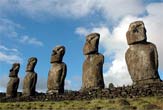
The first settlers on Easter Island didn't arrive until 1200 AD, up to 800 years later than previously thought, a new study suggests.
The revised estimate is based on new radiocarbon dating of soil samples collected from one of oldest known sites on the island, which is in the South Pacific west of Chile.
The finding challenges the widely held notion that Easter Island's civilization experienced a sudden collapse after centuries of slow growth. If correct, the finding would mean that the island's irreversible deforestation and construction of its famous Moai statues began almost immediately after Polynesian settlers first set foot on the island.
The study, conducted by Terry Hunt of the University of Hawaii, Manoa and Carl Lipo of California State University, Long Beach, is detailed today in the online version of the journal Science.
The conventional story
According to one widely held view, a small band of Polynesian settlers, perhaps no more than a few dozen people, arrived on the Easter Island sometime between 400 and 1000 AD.
The settlers lived in harmony with the environment for hundreds of years and the population slowly grew. Some scientists estimate that at its height, Easter Island's population may have been as much as 20,000 people.
Sign up for the Live Science daily newsletter now
Get the world’s most fascinating discoveries delivered straight to your inbox.
Around 1200 AD, the story goes, the inhabitants began cutting down the island's subtropical trees and giant palms in large numbers to build canoes and to transport the giant stone statues, which started going up around this time.
The large-scale deforestation led to soil erosion and over a span of several centuries, the island's ability to support wildlife and farming was compromised. People began to starve. In a last ditch effort at survival, they became cannibals.
The collapse of both the island's ecology and civilization was so complete that by the time the Dutch arrived in the 1700s, Easter Island was a sandy grassland void of nearly all its native wildlife; its human inhabitants were reduced to a starving population of 3,000 or less.
This is the story pieced together by researchers over the past several decades, but Hunt and Lipo think it is wrong.
No Garden of Eden
Crucial to the conventional account of events on Easter Island is the time when settlers first arrived. If colonization didn't begin until 1200 AD, then the island's population wouldn't have had time to swell to tens of thousands of people.
"You don't have this Garden of Eden period for 400 to 800 years," Hunt said in an accompanying Science article. "Instead, [humans] have an immediate impact."
Also, the few thousand people Europeans encountered when they first arrived on Easter Island might not have been the remnants of a once great and populous civilization as widely believed. The researchers think a few thousand people might have been all the island was ever able to support.
"There may not have actually been any collapse," Lipo told LiveScience. "With only 500 years, there's no reason to believe there had to have been a huge [population] growth."
Europeans and rats to blame
The researchers also dispute the claim that Easter Island's human inhabitants were responsible for their own demise. Instead, they think the culprits may have been Europeans, who brought disease and took islanders away as slaves, and rats, which quickly multiplied after arriving with the first Polynesian settlers.
"The collapse was really a function of European disease being introduced," Lipo said. "The story that's been told about these populations going crazy and creating their own demise may just be simply an artifact of [Christian] missionaries telling stories."
At a scientific meeting last year, Hunt presented evidence that the island's rat population spiked to 20 million from the years 1200 to 1300. Rats had no predators on the island other than humans and they would have made quick work of the island's palm seeds. After the trees were gone, the island's rat population dropped off to a mere one million.
Lipo thinks the story of Easter Island's civilization being responsible for its own demise might better reflect the psychological baggage of our own society than the archeological evidence.
"It fits our 20th century view of us as ecological monsters," Lipo said. "There's no doubt that we do terrible things ecologically, but we're passing that on to the past, which may not have actually been the case. To stick our plight onto them is unfair."
- Canyon Holds Ancient Civilization Secrets
- Ancient Mayan Canals Possibly Spotted in Satellite Images
- For Sale: Island with Mysterious Money Pit
Why is yawning contagious?
Scientific consensus shows race is a human invention, not biological reality









